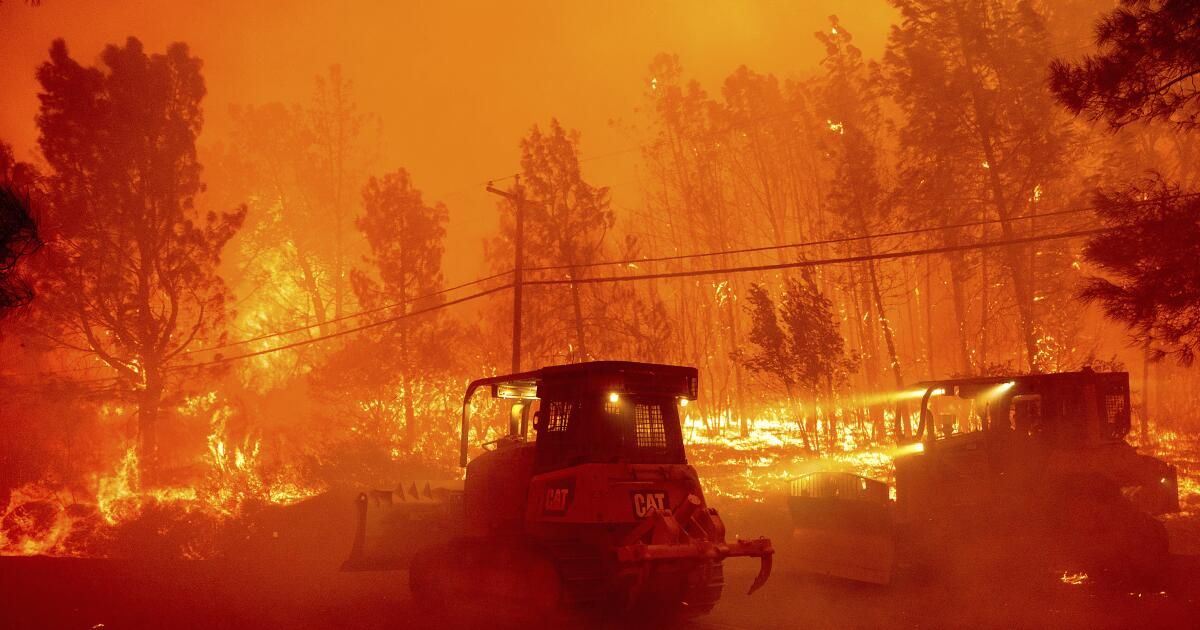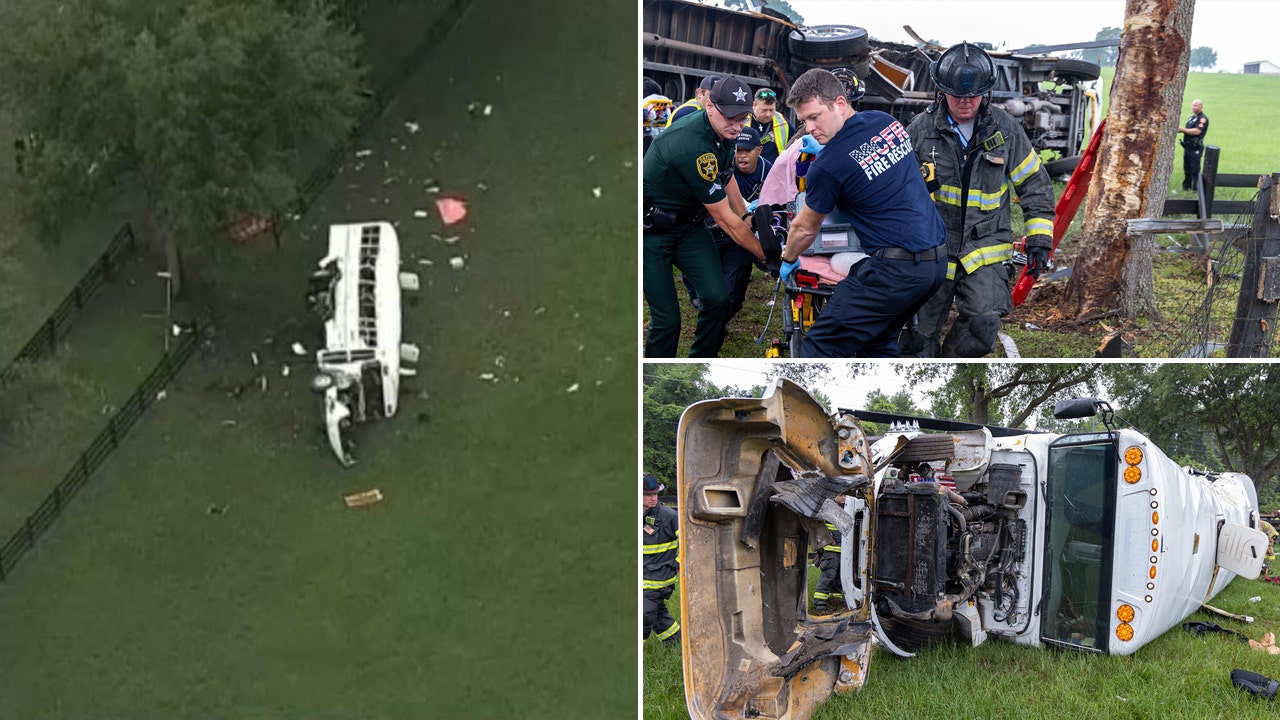Shortly before 3 p.m. Wednesday, as temperatures in Butte County hovered around 106 degrees, a man pushed a burning car into a ravine in Chico in what authorities say was an act of arson.
Within minutes, the burning vehicle ignited tall grasses that had sprouted after a wet winter but had dried out in recent weeks. Soon oaks and grapevines were ablaze, and wind-driven embers were racing down canyons and over the ridges of Lassen Hills, igniting the new growth as they touched down.
By nightfall, the Park Fire had reached 6,000 acres, and by the next morning it had grown sevenfold in size. By Friday, the blaze had surpassed 170,000 acres — the largest so far this year in California — and is out of control and showing little sign of slowing.
Experts say the fire's explosive growth is due to a perfect combination of hot, dry conditions, combustible vegetation and a landscape that hasn't burned in decades. The remote terrain has made it difficult for crews to access the fire's expanding perimeter, and fighting the blaze could be long and arduous as they struggle to gain a foothold.
“This is really the first fire in recent years in California that I would call extraordinary, and that’s not a good thing,” Daniel Swain, a climate scientist at UCLA, said at a briefing. “This fire is a big deal and it’s done some pretty incredible things.”
In fact, the fire and its massive plume of smoke have already displayed strange, erratic behavior, including “supercell thunderstorm-like characteristics” replete with large-scale rotations, Swain said. On Thursday, footage captured by AlertCalifornia wildfire cameras appeared to show the blaze spewing tornado-like vortices, sometimes referred to as fire whirls or fire tornadoes.
“At this point, the fire is creating its own weather, and that can be pretty unpredictable,” said Courtney Carpenter, a meteorologist with the National Weather Service in Sacramento. “Really large, explosive wildfires can create thunderstorms; they can form swirling columns of fire and can mimic tornadoes.”
The Park Fire's thunderstorm characteristics have not yet triggered lightning, though Carpenter said that's still possible due to the fire's “explosive growth” and extreme behaviors. He noted that smoke from the fire has already reached Oregon.
Fortunately, the fire’s rapid rate of spread has so far taken it north and east, spreading across northern Butte County and a growing portion of Tehama County, into a relatively remote mix of grass, brush and timber, and away from the threatened communities of Cohasset and Forest Ranch. But Swain said it will almost certainly become several times larger than it is currently, and will likely become a fire of several hundred thousand acres before it can be contained.
“This is a fire that is going to last for weeks, if not months,” he said. “It could be one of those fires that starts in mid-summer and continues into mid-fall … and it could end up posing a bigger threat to communities down the road.”
The fire has already left a trail of destruction. Chief Garrett Sjolund of the Butte County unit of the California Department of Forestry and Fire Protection said “numerous structures” have burned, including 134 buildings destroyed and another 4,000 that are in danger.
The fire, which started within Chico city limits, had an overwhelmingly favorable path, experts said, driven by dry southerly winds that blew it away from the city center.
Authorities have been concerned, however, about the community of Cohasset, where they initially feared a repeat of the 2018 Camp Fire, which swept through the nearby community of Paradise and killed 85 people — the deadliest wildfire on record in California. During that fire, dozens of people were trapped on the area’s limited roads as they tried to escape.
“Cohasset was of particular concern to us because … there’s only one exit and it’s a narrow, winding road,” said Butte County Sheriff Kory Honea. “It’s difficult to get through, so we wanted to get those warnings out as soon as possible.”
About 4,000 residents have been evacuated from Cohasset, Forest Ranch and parts of northeast Chico, along with several rural areas in southern Tehama County.
While the dry winds that drive fire-friendly weather conditions in the area typically come from the north, a less frequent pattern brought them in from the south this week and sucked out all the Bay Area moisture they typically carry with them, said Carpenter, the weather service meteorologist.
“There has been very dry and hot weather over the last month, and that’s why we’re seeing these critical fire conditions,” he said.
The area was under a red flag warning, which indicates dangerous weather conducive to rapid fire growth, on both Thursday and Friday.
That pattern has pushed the flames into wilderness areas that have been untouched by fire for decades, if not longer, filling them with thicker vegetation and dead and dying brush that ignite easily and quickly.
“There are tremendous amounts of live and dead fuels,” said Dan Collins, spokesman for Cal Fire's Butte Unit. He added that the Ishi Wilderness Area and parts of Cohasset “have zero to very limited fire history.”
The region's rugged topography makes firefighting efforts difficult, with steep cliffs, extensive canyons and few roads throughout the national forest.
“That's one of the big challenges, just getting people to… [to the fire lines] “because of the remote area,” Collins said.
The blaze is not the only wildfire of concern in the West. Cal Fire is battling more than 20 active fires in the state, while crews in Canada are fighting an 89,000-acre blaze in the province of Alberta that has already scorched parts of the historic resort town of Jasper. Experts say many of the fires have been fueled by the persistent, record-breaking heat wave that has blanketed the West for weeks.
Chico area residents are anxiously watching the Park Fire unfold.
“It’s been a pretty hectic time for us,” said Don Hankins, a professor of geography and planning at Cal State Chico who also serves on the Butte County Fire Safety Council.
The Big Chico Creek Ecological Reserve, where he conducts much of his research, has already burned and cameras indicate that nearly all of its infrastructure, including an 1870s barn, has been lost, Hankins said.
While the fire has some echoes of the Camp Fire, the Cohasset community has prepared in recent years for a potential fire, Hankins said, including fuel reduction projects and prescribed burns to help clear some of the combustible material that lies between the town and wildlands.
“But unfortunately, with the winds that are blowing and the scale of these projects, it’s not necessarily enough to make a difference” if the fire continues to rage out of control, he said.
More acreage is likely to be added to the fire in the coming days and weeks as crews contend with rugged, volcanic topography and persistent hot, dry conditions.
“The outlook is that it’s not going to be easy to contain,” Hankins said. “We’ve got a long season ahead of us before the rainy season comes, and that’s really going to be the last thing that can be done to slow down any of these fires that are going on in the West right now.”
Butte County Fire Chief Sjolund said he's hopeful that the expected drop in temperatures and increased humidity this weekend could help fight the Park Fire and others in the region.
“It’s like a moving target because of the way the weather patterns are going,” he said. “This fire is moving very quickly.”












